Adam just got a big, beautiful new Formlabs Form 3L resin printer. He decides to build a basic, sturdy cart to hold this monster.
He builds the stand and then sets up the printer and prints his first file.
Auto Added by WPeMatico
Adam just got a big, beautiful new Formlabs Form 3L resin printer. He decides to build a basic, sturdy cart to hold this monster.
He builds the stand and then sets up the printer and prints his first file.
Luke at Geek Gaming Scenics wanted to know how much he could down-scale a print for a fantasy miniature on a resin printer and still see most of the detail. And, how small could a miniature be and still be paintable. He scaled up a mini STL file to 54mm and all the way down to 6mm.
They all printed successfully, but as he points out, minis that are designed to actually be 6mm have exaggerated proportions to look more natural, so scaling down a 32mm or 25mm mini makes things extremely difficult to paint.
BioCosplay shows us how he casts a Mask in Resin on Youtube!
In this video I show you how I cast a mask using smooth cast 300
Website – biocosplay.net
Instagram – instagram.com/biocosplay
Check out his youtube channel!
 Every Wednesday is Wearable Wednesday here at Adafruit! We’re bringing you the blinkiest, most fashionable, innovative, and useful wearables from around the web and in our own original projects featuring our wearable Arduino-compatible platform, FLORA. Be sure to post up your wearables projects in the forums or send us a link and you might be featured here on Wearable Wednesday!
Every Wednesday is Wearable Wednesday here at Adafruit! We’re bringing you the blinkiest, most fashionable, innovative, and useful wearables from around the web and in our own original projects featuring our wearable Arduino-compatible platform, FLORA. Be sure to post up your wearables projects in the forums or send us a link and you might be featured here on Wearable Wednesday!
Check out the newest project tutorial from Erin St. Blaine: make an epoxy resin Minecraft-inspired torch lamp. This lamp has a strand of warm white fairy lights embedded right into the resin, making a lovely starry glow effect. Adding a Circuit Playground Express underneath powers up the lamp with 10 programmable NeoPixel LEDs. The included MakeCode downloadable code makes the lamp flicker like a torch for a really beautiful ambient lighting effect.
From the guide:
Make your own custom Minecraft-inspired Torch lamp from epoxy resin. Embed a strand of fairy lights inside, and set it on top of a Circuit Playground Express. The onboard NeoPixel lights provide a lovely, flickery torch effect. This gorgeous lamp glows from the inside out.
Add a piece of shiny copper tape to the base, and you can change light modes with a touch of your finger. Capacitive touch control is just like magic!
We’ve provided a simple 3d printable base model, or you can get creative and design your own display mount. We made ours look like Viking Dragon Ships to go with our Dragon Wall Sconce, and now we sail into sleep at night with fiery dragonish gargoyles watching over us.
Learn to make your own Resin Torch Lamp here: https://learn.adafruit.com/epoxy-resin-torch-lamp-with-touch-control-3d-printed-base
inventgeek posts a project video on how to build a resin 3D printer part washer and stir plate.

The brilliant, ever-curious Andrew “bunnie” Huang has posted an exhaustive tear down of the Formlabs Form 3 SLA 3D printer, released last year. In the nearly 7,000-word article, bunnie offers up his first impressions, does some test printing, and then gets to work deconstructing the machine. He identifies some of the machine’s strengths and weaknesses, speculates on the reasoning behind various design decisions, and attempts to identify parts sources. He even includes a sound clip of what the LPU (light processing unit) sounds like as it scans.
One problem that became immediately evident to me, however, was a lack of a way to put the Form 3 into standby. I searched through the UI for a soft-standby option, but couldn’t find it. Perhaps it’s there, but it’s just very well hidden. However, the lack of a “hard” button to turn the system on from standby is possibly indicative of a deliberate choice to eliminate standby as an option. For good print quality, it seems the resin must be pre-heated to 30C, a process that could take quite some time in facilities that are kept cold or not heated. By maintaining the resin temperature even when the printer is not in use, Formlabs can reduce the “first print of the day” time substantially. Fortunately, Formlabs came up with a clever way to recycle waste heat from the electronics to heat the resin; we’ll go into that in more detail later.

The other thing that set the Form 3 apart from its predecessors is that when I looked inside, there were no optics in sight. Where I had expected to be staring at a galvanometer or mirror assembly, there was nothing but an empty metal pan, a lead screw, and a rather-serious looking metal box on the right hand side. I knew at this point the Form 3 was no incremental improvement over the Form 2: it was a clean-sheet redesign of their printing architecture.
Thoughtful tear downs like this do the maker community a great service — bunnie field-strips it so you don’t have to. It’s also wonderful that Formlabs themselves offered up this unit to the slaughter.
If you’re interested in seeing and comparing his tear downs of the Form 1 and Form 2, he has links to these articles in the first paragraph of the piece.
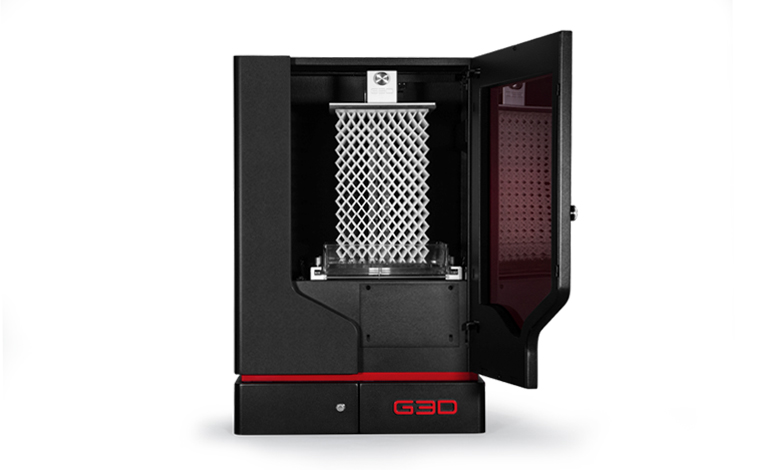
T-1000 DLP 3D Printer by G3D
The T1000, manufactured by G3D, has disrupted the desktop SLA 3D print industry. The unit has the largest build volume with the fastest build speed in its price category and represents the most cost-effective solution for newcomers to skilled engineers for complicated prototypes.
G3D announces lifetime warranty and upgrades to new products for universities, colleges and other educational institutes as well as prototype manufacturers. For details contact www.g3dsys.com.
Dubbed the T-1000, the DLP SLA product of G3D is designed to have the cost-effectiveness and large build volume of FDM machines while also having the quality and high-tech appearance of SLA machines. For their Black Friday promotion, G3D is offering the printer for only $1,500! This offer is available for November 29 – December 10 2019 only!
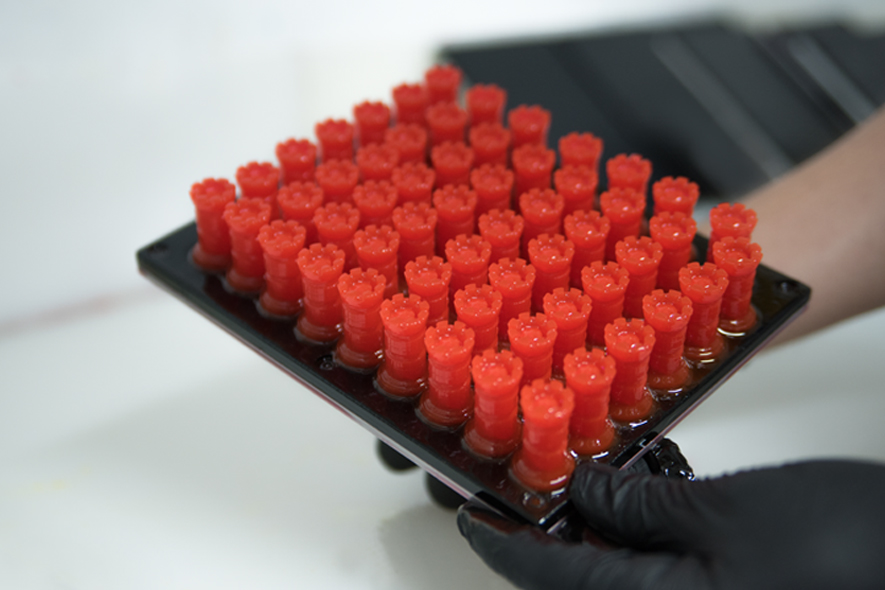
Batch of rook models printed on the T-1000 (56 models)
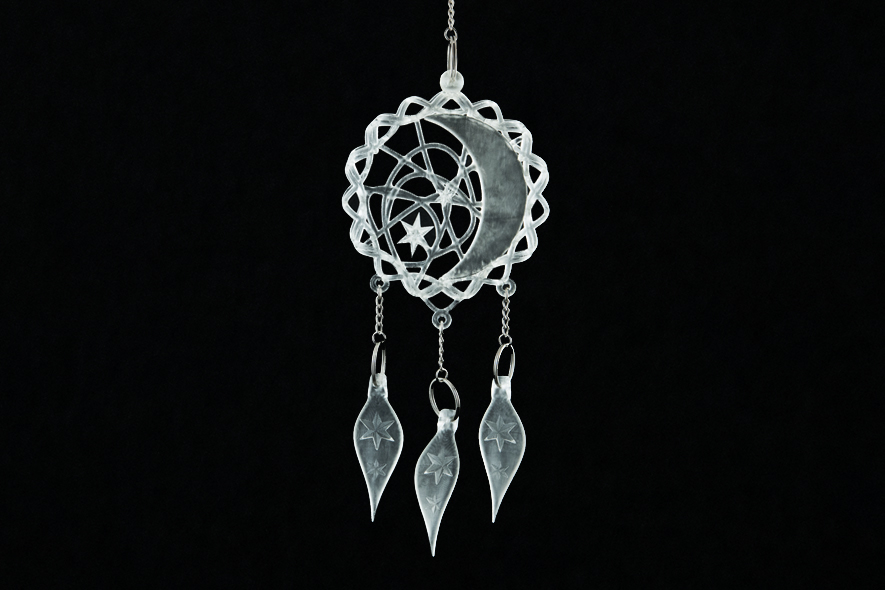
Dreamcatcher printed in the T-1000 using clear resin
The T-1000, having a maximum build volume of 7.06 in x 5.29 in x 11.81 in allows users to print models with large print volumes like a leg prosthetic model or an almost 12 in replica of the Eiffel tower:

Prosthetic leg model printed in the T-1000
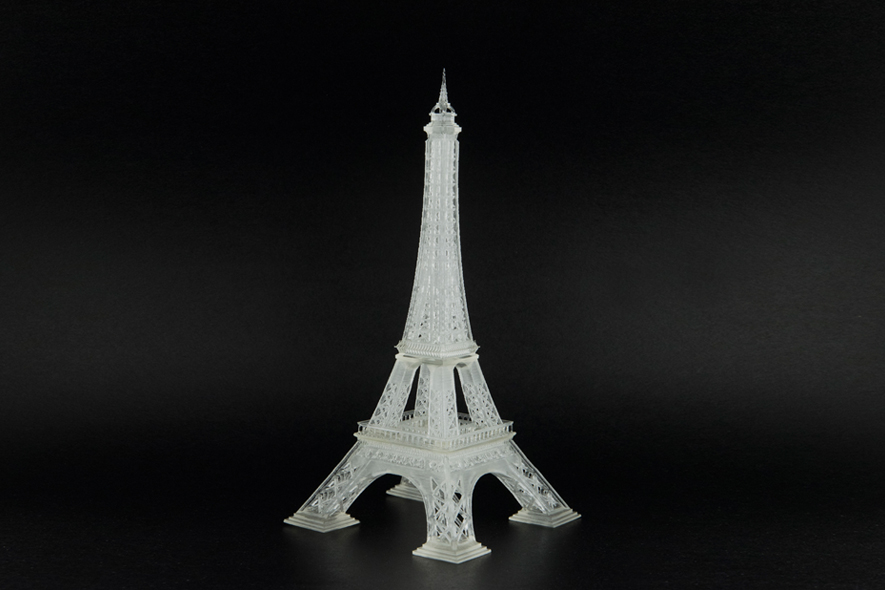
Almost 12-in replica of the Eiffel Tower printed on the T-1000
To cater to the varying demand of users of 3D printer machines, the T-1000 was also designed to have a small volume print configuration where the user can increase the quality of the prints up to 100 μm x-y resolution and 7.5 μm layer height for finer and more detailed prints.

Small gears printed on the T-1000 using Black Matte resin
To change the printer settings from large build volume to small build volume the user would only need to turn a knob on the T-1000 to change the configuration, recalibrate the printer for this new setting and update the slicer settings in the software. G3D designed the T-1000 to be this easy with no need for replacing or upgrading parts.
With this quality and size, the T-1000 also doesn’t miss on the speed. The T-1000, with the backbone of Digital Light Processing technology where the cross-section of the model is cured all at the same time, can achieve maximum speeds of up to 2.6 in/hr. This means you can print a max build on the printer (11.8 in) in only 4.6 hours. Compared to laser SLA technologies and FDM which traces the cross section of the object being printed, DLP, because it cures the whole cross section at the same time, allows the user to print for the same length both 1 model or multiple models on the build plate. G3D endorses that this capability will allow users to 3D print multiple models per batch without worrying about increasing the printing time.
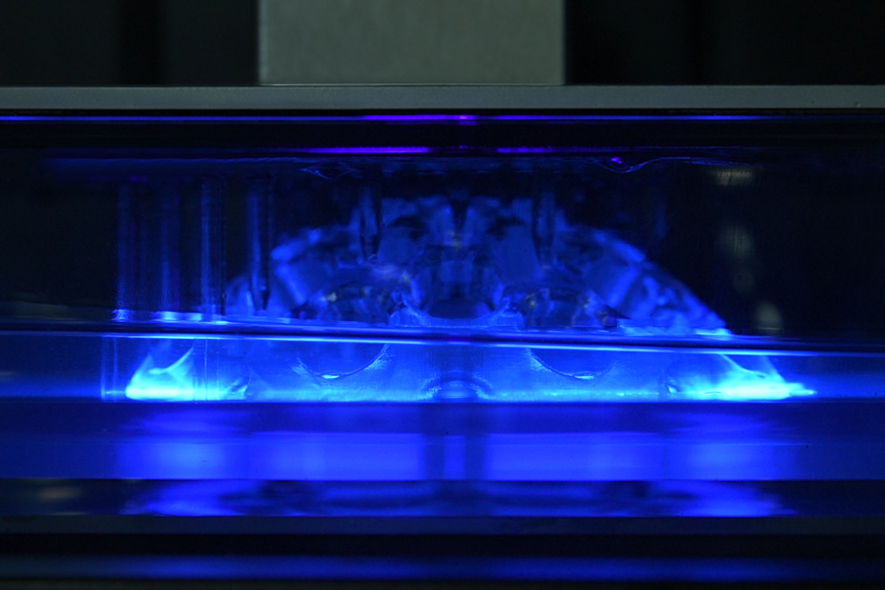
Digital Light Processing (DLP) of the T-1000 in action
For prototyping activities this speed reduces the turnaround time to produce prototypes allowing engineers and designers to rapidly verify their designs and models speeding up their rapid prototyping process.
With this affordable price, especially with the Black Friday promotion, schools would also be able to affordably purchase and use the T-1000 allowing them to experience a fast, reliable and high-volume 3D printer, the next generation of 3D printers in their own classrooms.
Ease of use was also put in mind with the patented 4-point Bed Calibration System. Coupled with the tilting mechanism for easier peeling of the model from the FEP film, the T-1000 can produce prints unsupervised.
Another factor that increases the cost-effectiveness of the T-1000 is the consumables which are only the resin and vat, this would only cost the user around $75/L (standard resin) and T-1000 vat ($45, 30L life).
Comparing to a known SLA 3D printing machine manufacturer using G-Boy (a G3D standard model) with a volume of 13.8 ml, printing using their clear resin would cost the user around $2.06/model ($149/L) while printing using G3D clear resin would only cost around $1.04/model ($75/L).
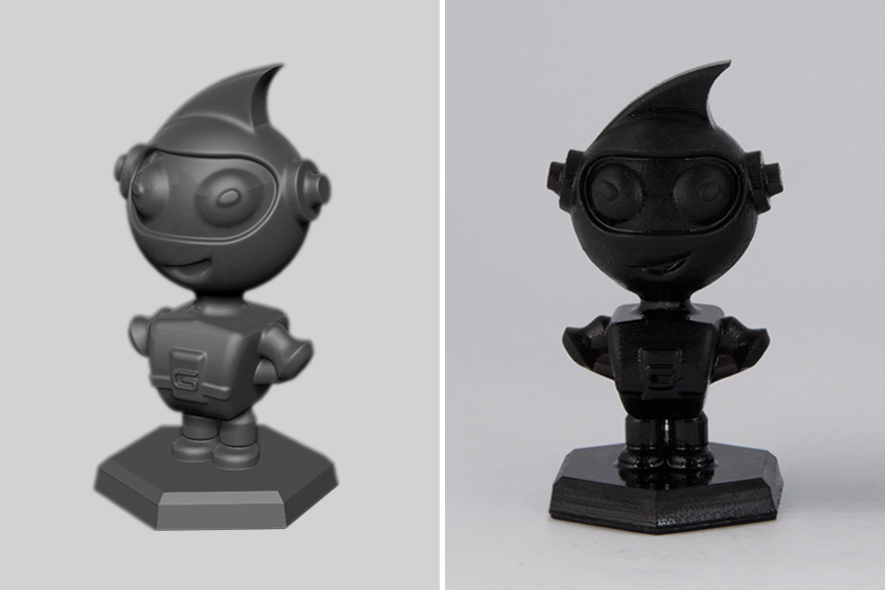
G3D G-Boy model computer file (left), 3D printed using T1000 (right)
For heavy users consuming 5L/week, this translates to more savings. For the competitor’s resin this would cost the user around 5L times $149/L ($745) plus $59/2L times 5L ($147.5) for resin tank (standard) replacement every 2L for a total of $892.5/week or $46,410/year. Using G3D T-1000 this will only cost the user 5L times $75/L ($375) plus $45/30L times 5L ($7.5) for G3D vat replacement every 30L for a total of $382.5/week or $19,890/year. Using G3D T-1000 for high volume prints will save you $26,520/year! Allowing you to purchase a lot more 3D printers and scale your capabilities.

Operating cost comparison for G3D and SLA Competitor
But wait there’s more! For heavy volume users, G3D promises to replace the vat for FREE when ordering for more resins if there are signs of wear and tear before using more than 10L!
G3D have also invested in producing quality resins to make sure customers would be satisfied in the G3D platform. Currently, the company has the following resins:
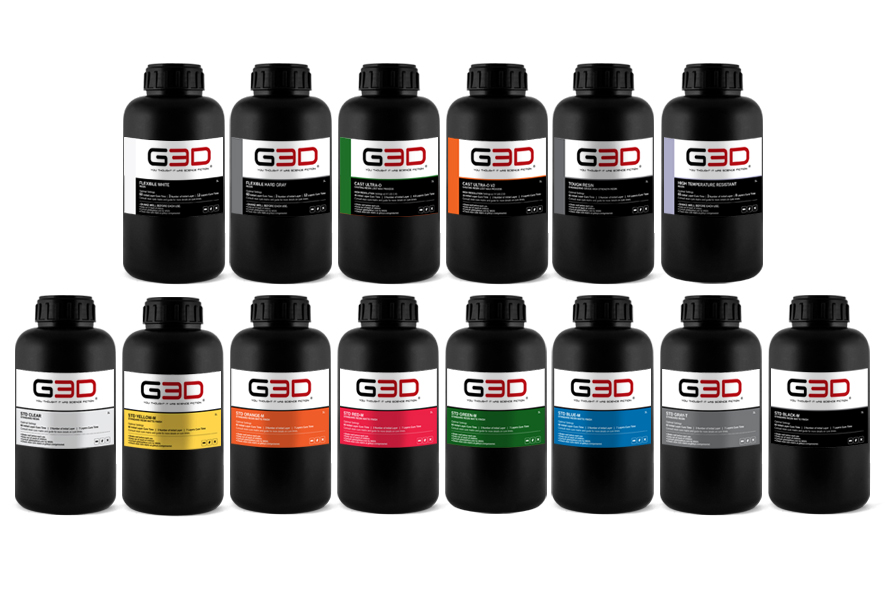
Resins produced by G3D (same color labels are matte and non-matte options)
Each of the standard and colored resins only cost around $75/L and available in colored and matte colored options.
G3D resins also include functional resins for functional 3D printing. The company has Tough resin ($85/L) designed to withstand 6000 psi of pressure (equivalent to 6000 pounds of force per square inch) for functional parts and prototyping. Flexible resin ($109/L) for soft parts and flexible parts. And Heat resistant ($105/L) resin that can withstand 500 degrees Fahrenheit temperature for high temperature resistant parts and models.
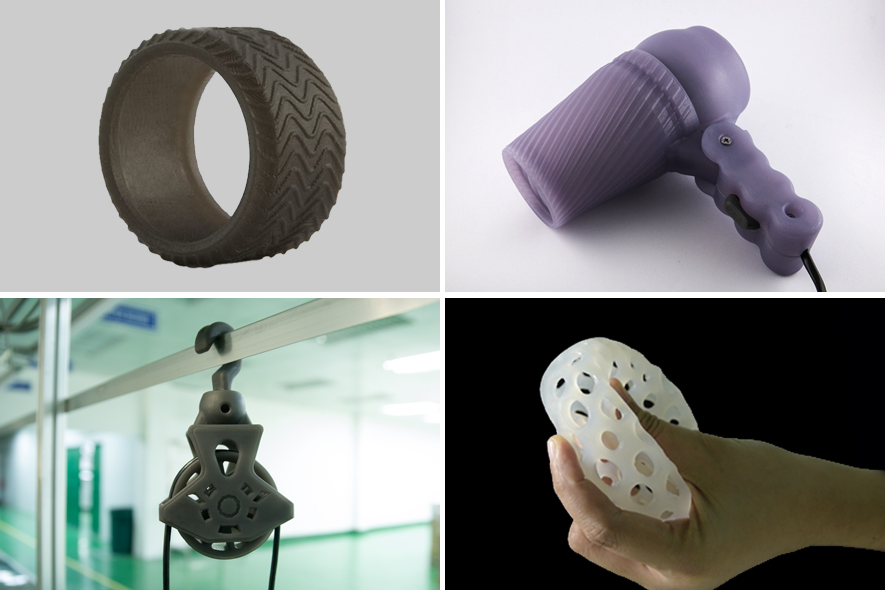
Functional resins by G3D (from top-left clockwise) Flexible resin gray, Heat Resistant resin, Flexible resin white, and Tough resin
G3D also doesn’t limit the user on the resins that you can use on their printer. The printer was designed to have no custom fit container, no complex loading mechanisms, so the user can pour and use any resin he likes, just make sure that the resin is designed for 405nm DLP 3D printing as the light engine of the T-1000 emits curing UV at 450 nm wavelength. This simple design also prevents clogging and other 3D printer problems from the resin.
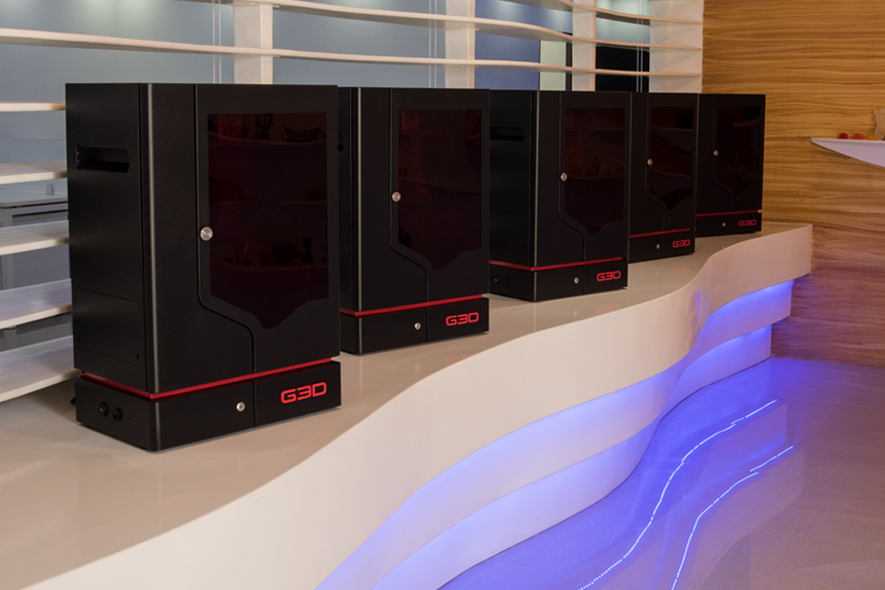
G3D T-1000 in the showroom
You can see more sample prints by G3D through following their Instagram page.
The post Large Build Volume, High Quality, Fast and Cost Effective, The G3D T-1000 appeared first on 3DPrint.com | The Voice of 3D Printing / Additive Manufacturing.
I am excited to do some research and follow up based on some topics and discussions I heard on Dezeen Day. This particular discussion is based on an artist who has done some interesting and fascinating work within 3D Printing that I would like to talk about. I find it interesting a current movement within the art world of exploring scientific concepts within work. Art and design are starting to fuse a bit more with scientific thinking, and it is an interesting development we should be watching for the future. This particular artist will be showcasing a little of this type of thinking.
Aki Inomota is a Tokyo-based artist. She was born in Tokyo in 1983. She also completed an MFA at the Tokyo University of the Arts. Her degree was in Inter Media Art. Her work was mentioned within the Dezeen Talk from Paola Antonelli. Paola has curated Aki Inomota’s work in one of her recent projects at MOMA. The piece, in particular, is named Think Evolution #1. This particular piece is a resin casted ammonite fossil.
Ammonites are an extinct species. They are usually one of the most well known and distinguishable fossils to the normal human. They are excellent index fossils. One can link the rock layer they were found to specific geological time periods. These fossils usually have great preservation as well.
This particular ammonite fossil was cast with resin. I think that art is interesting in that it can be the simplest things and ideas that make remarkable pieces. Many of us could do this simply and effectively through 3D Printing, but this particular artist had the creativity to do it. The value of creativity is something to harp on continuously.
In terms of the piece itself, the message is interesting. When this piece is placed near an octopus in water, an octopus will form itself within the shell. Octopus and ammonites are related in terms of species, so it is interesting to see how an octopus feels comfortable within this foreign shell. Octopus have grown out of the need for their shells through evolution, but this shows that they are comfortable using them still.
Aki Inomata’s “Think Evolution #1 : Kiku-ishi(Ammonite)” an octopus exploring its ancestral biological habitat. pic.twitter.com/wi8DvWH1NG
— matthew blunderfield (@_blndrfld) August 15, 2019
This piece was curated by Paola because of her thoughts on extinction and how it relates to humanity. We all are going to die at some point. This is our impending reality, but how do people act upon this? How do people change things for the better? If we know we shall die, what do we do to make our lives and the lives of others better?
I think that with this piece, my opinions come from a different perspective. I am intrigued by how the octopus is playing naturally with this resin cast piece. The octopus recognizes as something of familiarity. When one has an intuitive feel for something, what can explain that? I find it fascinating that something that is instinct still has a familiarity to a descendant or relative species way down the line.
There are a large number of octopus species that devise shelters out of coconut and mollusk shells. The goal of this piece was to explore the effect of transmitted evolutionary knowledge. Inomata recreated an ammonite shell by leveraging 3D scanning to recreate a digital model of the shell.
Using 3D printing to do this artistic piece is very fascinating. I would love to know people’s opinions on this in particular. What should we be doing to prepare for extinction? What does this piece do in terms of shifting your perspective in the way you live?
Discuss this and other 3D printing topics at 3DPrintBoard.com or share your thoughts below.
The post Aki Inomota – Think Evolution #1 appeared first on 3DPrint.com | The Voice of 3D Printing / Additive Manufacturing.
Martin Forth of RAPLAS wants to bring 3D printing to manufacturing. This is quite a popular narrative at the moment. But, far from the smoke and mirrors of startup land, there are real reasons to believe Martin’s effort over hordes of industry newbies; Martin’s experience, for one. Martin spent two years building RAPLAS and before that spent thirteen years at EnvisionTEC. This already means that he has significantly more experience than 95% of our industry. Only, before EnvisionTEC, Martin spent six years at 3D Systems, joining the 3D printing industry in 1996. 1996. Independence Day, Trainspotting, Braveheart, No Diggity, Unbreak my Heart, Clinton, 1996. Thanks to AMUG, we now consider veterans of 3D printing Dinosaurs, but Martin is practically a fern. He’s seen it all and tried to implement rapid prototyping, free form fabrication, rapid manufacturing and what not previously. So when he gets together a super experienced firm to bring production 3D printing technologies to manufacturing with a focus on resins, sand, and metal, all with open materials, we take notice.
What is Raplas?
Raplas was set up in 2014 and develops technical solutions for industrial manufacturing and high-quality prototype development. Currently, we have released systems for the production of plastic parts and for casting applications and have shown early samples from our metal printing technology. We are focusing on high-end manufacturing applications hence the size and performance of our equipment.
How did you evolve as a firm?
Raplas grew from the experiences of the board within the additive industries, who have all worked within the additive industries since the mid 1990’s, we felt that current technology was not addressing the needs of production manufacturing entirely , either through cost of equipment or materials, repeatability for large batch production, accuracy, surface finish or speed. So we set about designing and marketing technology that could satisfy these requirements. All of the board, management and staff of the company have come with many years of valuable experiences of using, designing and marketing this type of technology as well as the knowledge of operations in associated industries.

What kind of machines do you make?
We make machines and materials for all additive applications all are large frame to suit the professional production markets and fully open allowing the users the widest choice of materials at competitive prices.
Why large scale SLA?
We always felt that SL has always been the gold standard when the combined attributes were added together, but had a long way to go to realise its true possibility. Our understanding of capabilities and requirements showed there was a strong need in the market for a machine that moved the technology on to another level- this was what we brought to our first beta customers with our generation one machines. When we introduced our gen2 machines we really moved forward by another considerable step in productivity and capabilities . Our Gen 2 Systems are very fast compared to other competing technologies, that is consistently physically accurate to within 50 micron over the entire build area, so it makes sense to utilise a large build area for production purposes. For instance we have a client that produces over 1000 electrical components in one build which lasts approx. 4 to 5 hours so they can produce 4000 components per day. The total annual production is 15,000 sets with 6 components per set… so the annual requirement is 90,000 parts in total. All of these parts can be printed in less than a week and have no need for 6 injection mould tools.
What do your customers use the systems for?
Manufacturing end use parts as well as prototypes and short test batches.
What industries use your systems?
All applications from Automotive to Audiology, Dental, Medical, NPD, through to tooling and casting.
Why should I work with you?
We feel the merits of our technology and experience of our customers is a compelling reason for potential customers to work with us. We always put the customer’s needs first and are prepared to tailor our solutions to particular clients needs if required. We recognise that a one size fits all approach doesn’t work in a production environment as clients have existing processes that we have to work alongside with. This may mean matching various speeds or material properties to fall in line with current expectations through optimisation of the system through to developing new materials specific for that client.
What kinds of materials do you offer?
We have a general purpose ABS resin in white, gray and crystal clear , class IIb medical grade resin and castable resins that have a low HDT and low ash. For mold manufacture we offer Sand and Ceramic options as well as polymer solutions for direct mold manufacturing. With our forthcoming metal solution, there will be a number of technical materials and it will initially be offered with stainless and aluminium.
What exciting new applications are you seeing emerge?
We’re seeing strong demand for extra mechanical properties and we are working with a number of different players to deliver unique solutions to customer needs. As we see Electronic devices getting smaller more precise components are required; this is pushing the boundaries of injection moulding.
3D printing has the ability to disrupt traditional manufacturing process as a solution and not just because of low volume requirements, but because of our ability to produce small technical features which are easy to produce in AM, but in the conventional manufacturing world this can be unjustifiable or economically impossible for the moulding market.
So as electronic packaging becomes more of a technical issue we will see more firms endorse 3D printing as manufacturing solution.
What is holding back 3D printing?
Poor understanding of the value of the technology to customers and the constant attempts to shoehorn the wrong technology to customers by some manufacturers. Another thing is the cost of materials. Often the process is disregarded as production solution because of high component costs , now the 3D Printers are becoming faster the largest cost element of the component is now the material.
What advice would you give a company interested in using 3D printing for manufacturing?
“Listen to your customers and suppliers more and deliver what they want not necessarily what you think he wants…”
The post Interview with Martin Forth of RAPLAS on Open Materials Manufacturing With 3D Printing appeared first on 3DPrint.com | The Voice of 3D Printing / Additive Manufacturing.
Longer Orange 30 LCD Resin 3D printers are now available on Kickstarter. Super early birds can pledge for the printer at $199, while early birds can pledge for the printer at 50% off retail price.
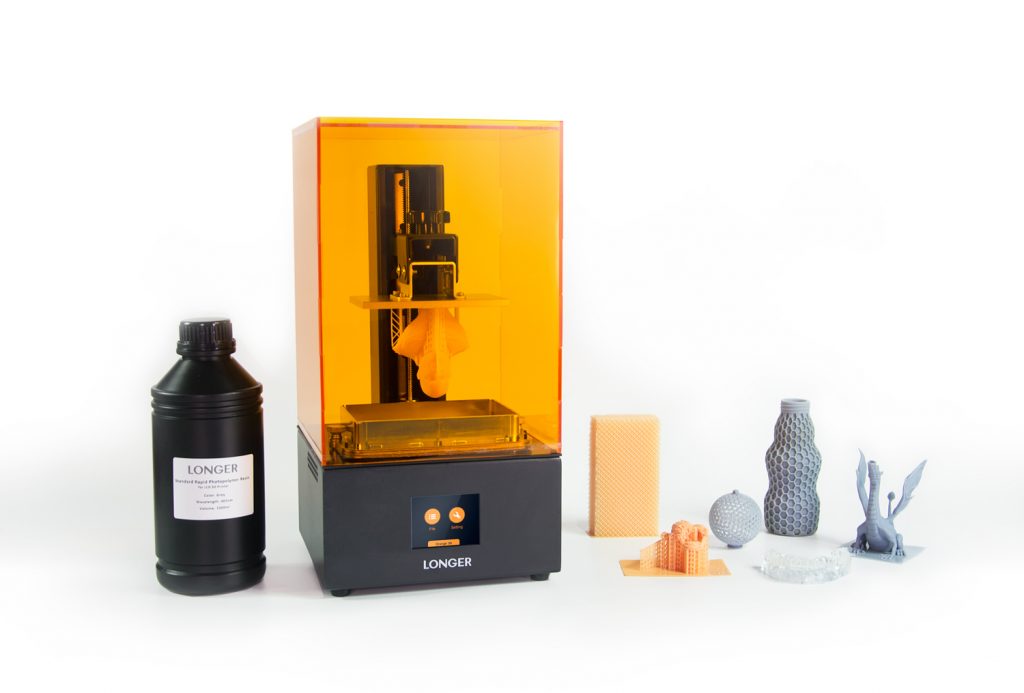
Longer3d, based in Shenzhen, China, is a company specializing in additive manufacturing. Its product portfolio includes hobbyist desktop FDM (fused deposition modeling) printers and industrial metal machines for professional standards. Owning a factory gives Longer3d’s R&D staff the opportunity to repeatedly test the performance of its machines. To achieve mass production requires not only supply chain support for a product design, but also experienced factory operations to reduce non-performance rates through quality control processes.

As a new SLA resin 3D printer, the Orange 30 is an affordable proposition for professionals working in high-detail industries such as jewelry, dentistry, architecture, industrial design, model making and art.
Orange 30 uses LCD-based UV shielding technology; uniform UV LED array light source and special optical path design can achieve high contrast and uniform distribution of surface light source, avoiding debris during printing. This ensures that the print details are smooth.
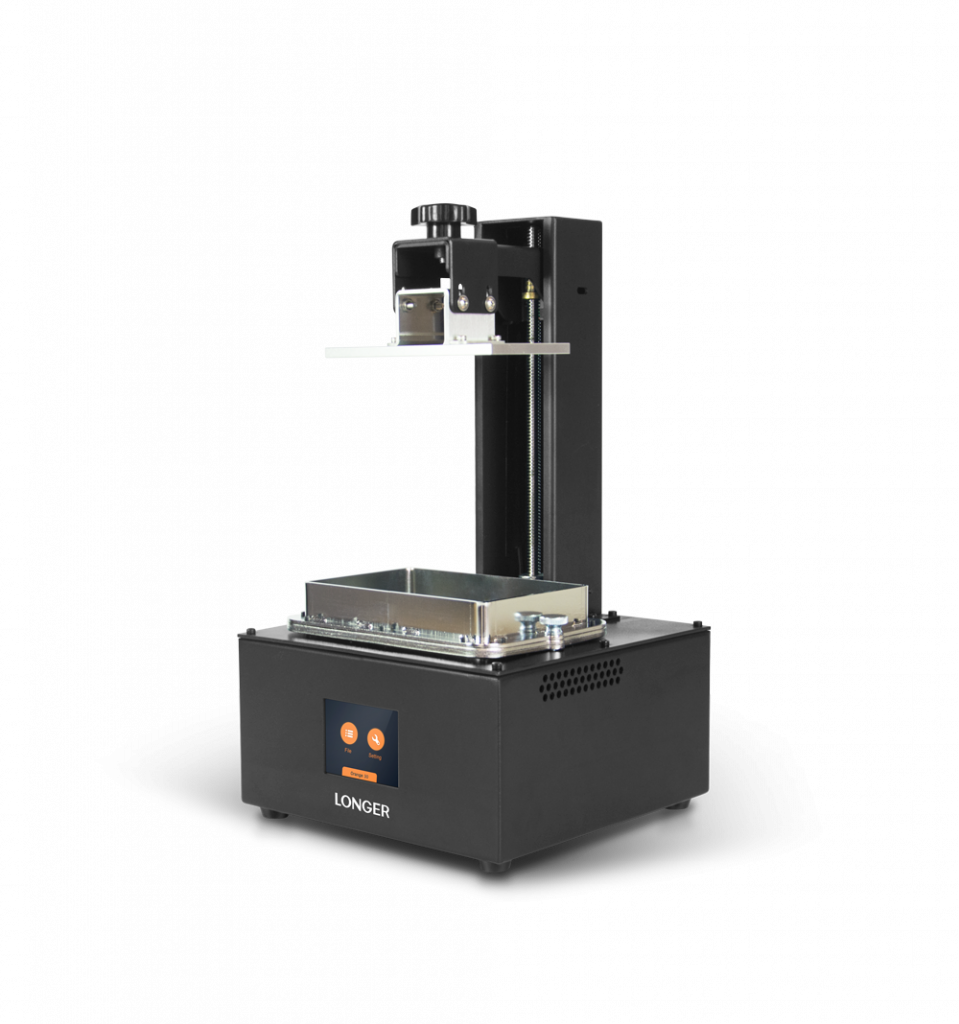
Smart support is another feature of this printer. It can automatically detect the suspended parts with one button and automatically add cross-linked grid support to improve the success rate of complex model printing, which avoids the loss of support at critical times. Moreover, Longer provides professional-grade slicing software.

In terms of design, the Orange 30 features a sturdy, all-metal and one-piece design with a UV-resistant orange cover for high visibility. It offers a fairly large 120 x 68 x 170 mm build volume, which is larger than the equivalent on the market. And the 2.8-inch full-color touch screen provides users with instant feedback, making it easy to select files for printing and view the process.
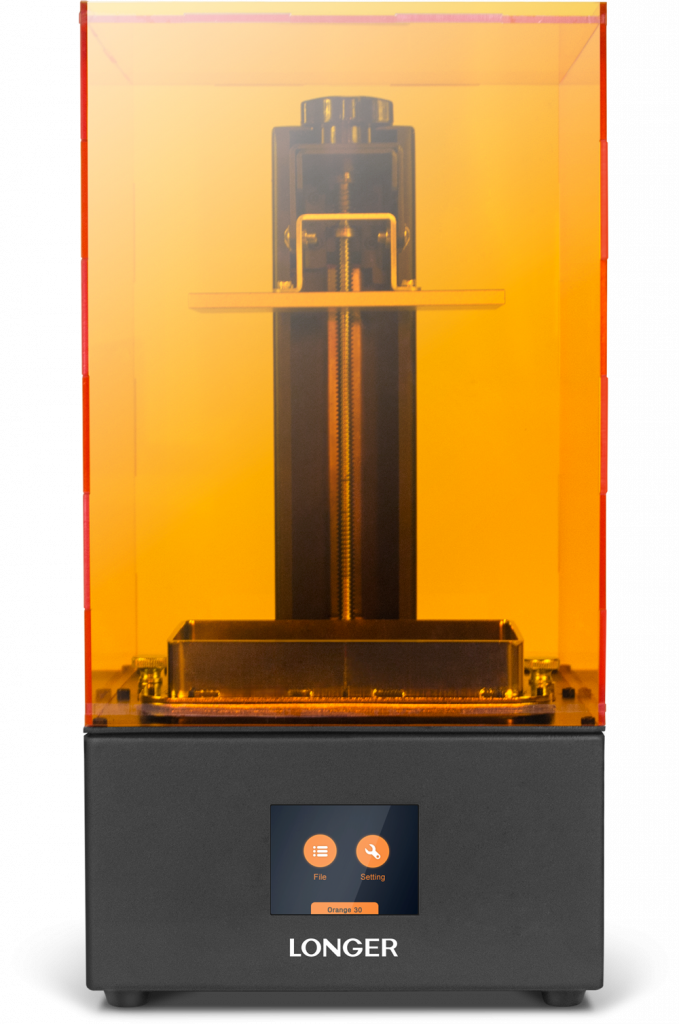
The Orange 30 brings a other enhancements to the printing experience such as high temperature warning: Real-time detection of LED operating temperature during printing enables the printer to automatically pause or stop when temperature is abnormal, and automatically resume printing when the temperature normalizes.
Orange 30 offers a 2K LCD screen of 2560*1440, 47.25μm, and it offers superior detail compared to many other FDM printers.
Longer’s new line of resins complements its affordable 3D printer, with up to 6 colors of resin to choose from, making it easy to print a wide range of applications.
If you want to take advantage of the super early bird deal visit Kickstarter to learn more about the affordable and capable Orange 30.